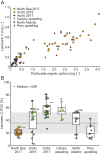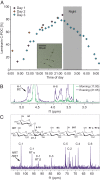Laminarin is a major molecule in the marine carbon cycle
- PMID: 32170018
- PMCID: PMC7104365
- DOI: 10.1073/pnas.1917001117
Laminarin is a major molecule in the marine carbon cycle
Abstract
Marine microalgae sequester as much CO2 into carbohydrates as terrestrial plants. Polymeric carbohydrates (i.e., glycans) provide carbon for heterotrophic organisms and constitute a carbon sink in the global oceans. The quantitative contributions of different algal glycans to cycling and sequestration of carbon remain unknown, partly because of the analytical challenge to quantify glycans in complex biological matrices. Here, we quantified a glycan structural type using a recently developed biocatalytic strategy, which involves laminarinase enzymes that specifically cleave the algal glycan laminarin into readily analyzable fragments. We measured laminarin along transects in the Arctic, Atlantic, and Pacific oceans and during three time series in the North Sea. These data revealed a median of 26 ± 17% laminarin within the particulate organic carbon pool. The observed correlation between chlorophyll and laminarin suggests an annual production of algal laminarin of 12 ± 8 gigatons: that is, approximately three times the annual atmospheric carbon dioxide increase by fossil fuel burning. Moreover, our data revealed that laminarin accounted for up to 50% of organic carbon in sinking diatom-containing particles, thus substantially contributing to carbon export from surface waters. Spatially and temporally variable laminarin concentrations in the sunlit ocean are driven by light availability. Collectively, these observations highlight the prominent ecological role and biogeochemical function of laminarin in oceanic carbon export and energy flow to higher trophic levels.
Keywords: carbon cycle; diatoms; diel cycle; glycans; laminarin.
Copyright © 2020 the Author(s). Published by PNAS.
Conflict of interest statement
The authors declare no competing interest.
Figures





References
-
- Field C. B., Behrenfeld M. J., Randerson J. T., Falkowski P., Primary production of the biosphere: Integrating terrestrial and oceanic components. Science 281, 237–240 (1998). - PubMed
-
- Biersmith A., Benner R., Carbohydrates in phytoplankton and freshly produced dissolved organic matter. Mar. Chem. 63, 131–144 (1998).
-
- Engel A., Thoms S., Riebesell U., Rochelle-Newall E., Zondervan I., Polysaccharide aggregation as a potential sink of marine dissolved organic carbon. Nature 428, 929–932 (2004). - PubMed
-
- Aluwihare L. I., Repeta D. J., Chen R. F., A major biopolymeric component to dissolved organic carbon in surface sea water. Nature 387, 166–169 (1997).
-
- Teeling H., et al. , Substrate-controlled succession of marine bacterioplankton populations induced by a phytoplankton bloom. Science 336, 608–611 (2012). - PubMed
Publication types
MeSH terms
Substances
LinkOut - more resources
Full Text Sources
Other Literature Sources

